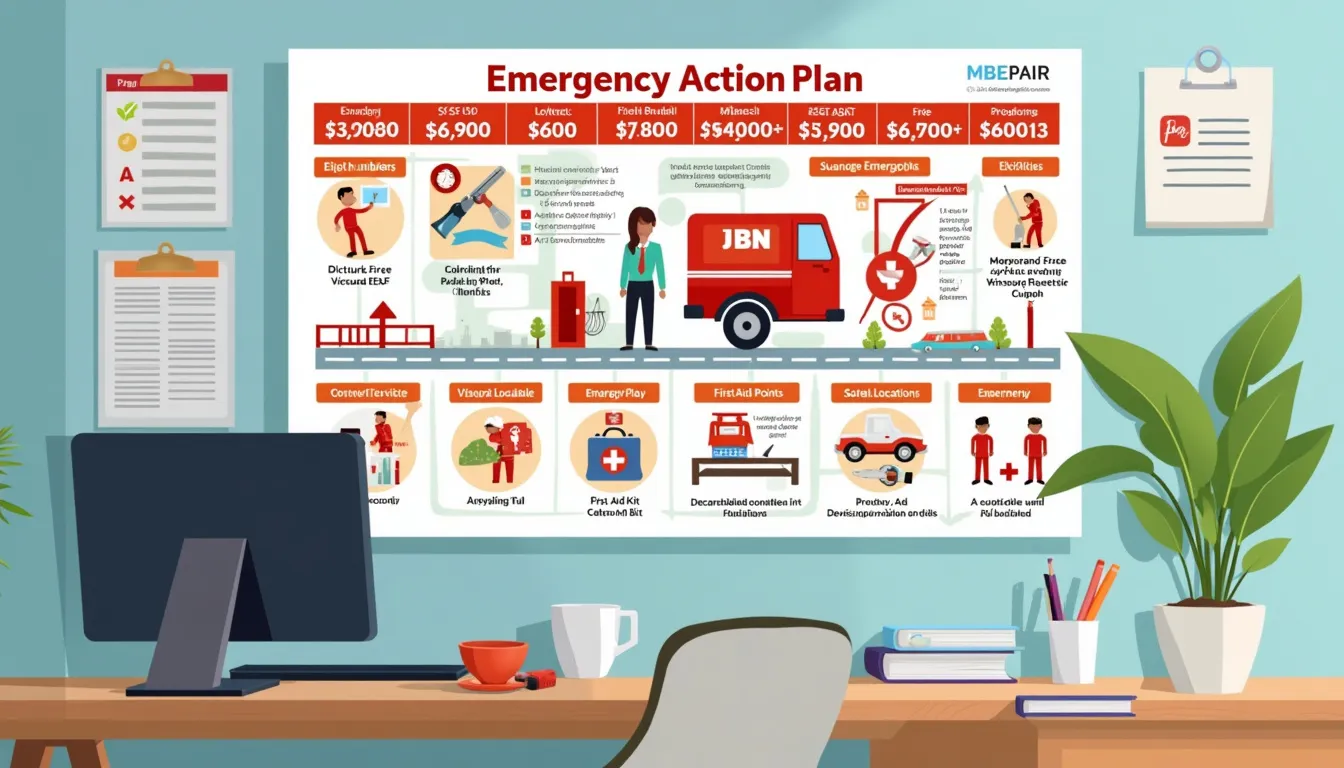In a world where unpredictability is the only constant, creating effective emergency action plans is not just a smart strategy—it’s an essential one for ensuring safety and preparedness. Emergency action plans serve as a blueprint for navigating various crises, offering a structured response to scenarios ranging from natural disasters like earthquakes and floods to man-made incidents such as fires and hazardous material spills. These plans are more than just documents; they are lifelines that empower organizations to act swiftly and efficiently when every second counts.
Understanding the core components of a comprehensive emergency action plan is crucial. It entails outlining clear evacuation routes, setting robust communication protocols, and maintaining updated emergency contacts. Importantly, each plan must be tailored to address specific threats pertinent to the organization’s unique environment. Whether preparing for a fire, an earthquake, or a flood, the specificity of the plan can make a significant difference in its effectiveness.
Developing and implementing an emergency action plan requires a methodical approach. From drafting the plan to involving employees and stakeholders, each step plays a pivotal role in its success. Regular training and drills are indispensable, ensuring that everyone is familiar with their roles and responsibilities during an emergency.
Evaluating and updating your emergency action plan is equally important. Regular assessments help gauge the plan’s effectiveness, while timely updates ensure it evolves with emerging threats. Learning from case studies and success stories can offer valuable insights into what works and what doesn’t, guiding continuous improvement.
By prioritizing well-crafted emergency action plans, organizations not only safeguard lives but also fortify their resilience against unforeseen events. The keyword here is preparation—a proactive stance today can avert chaos tomorrow.
Introduction to Emergency Action Plans
Emergencies are unpredictable by nature, but your response doesn’t have to be. This is where emergency action plans shine. These meticulously crafted blueprints are pivotal not just for minimizing chaos during unforeseen events but also for ensuring the safety and preparedness of everyone involved.
The importance of emergency action plans cannot be overstated. Consider them as the sharpest tools in your safety toolkit, designed to provide clarity and direction when it’s needed most. A well-constructed plan can be the difference between a streamlined, effective response and utter confusion.
Let’s face it: the spectrum of common emergency scenarios is broad. On one end, you have natural disasters like earthquakes, floods, and hurricanes, which demand immediate and precise action. On the other, there are human-made crises such as fires, chemical spills, and even active shooter situations. Each scenario requires a unique set of responses, emphasizing the need for a comprehensive and versatile emergency action plan.
We live in an era where anticipating the unexpected is not just wise but necessary. From minor incidents that disrupt daily operations to major catastrophes that pose fatal dangers, it’s critical to be prepared. A well-implemented emergency action plan can mitigate risks, safeguard lives, and ensure continuity in the aftermath of any emergency.
Emergency action plans are akin to life insurance—essential safeguards against life’s myriad unpredictabilities. The significance of these plans goes beyond mere compliance with safety regulations; they embody a proactive commitment to safety and preparedness. When lives are on the line, every second counts, and a detailed, actionable plan can make those seconds matter.
At the core of any effective emergency action plan is the principle of preparedness. This involves not just drafting a plan but also ensuring it’s integrated seamlessly into the daily operations of your organization. Emergency scenarios tend to escalate quickly, leaving no room for hesitation or second-guessing. Knowing exactly what to do, who to contact, and where to go can save precious lives and resources.
Additionally, it’s not just about having a plan on paper. The real test lies in its execution. Regular drills, training, and updates ensure that everyone involved is familiar with their roles and responsibilities. It’s about creating a culture of preparedness, where the knowledge of handling emergencies is ingrained and instinctive.
So, why wait for the worst to happen? Start today. Equip yourself and your organization with a robust emergency action plan, tailor-made to handle any crisis that comes your way. Your preparedness today is the security of countless lives tomorrow.
Safetyology – Get The Book Today!

Components of a Comprehensive Emergency Action Plan
Creating effective emergency action plans requires more than just a basic outline. For a plan to be truly effective, it must include several critical components designed to ensure safety and preparedness for any emergency scenario. Here’s a detailed look at the essential elements that every robust emergency action plan must incorporate.
Evacuation Routes
In the midst of a crisis, clear and accessible evacuation routes can mean the difference between safety and disaster. Your emergency action plan should map out multiple routes, allowing for safe and swift evacuation from various points in your building or area. Clearly marked exits, assembly points, and alternate paths should be outlined and visibly posted throughout the facility. Floor plans that highlight these routes should be readily available, and regular drills should be conducted to familiarize everyone with the evacuation protocol.
Communication Protocols
Effective communication is crucial during emergencies. Your plan must specify how information will be disseminated quickly and accurately. This includes designating roles, establishing clear chains of command, and ensuring that all employees understand how to report an emergency. Protocols should also encompass methods of communication such as intercom systems, emergency phone numbers, and mobile alerts. Additionally, backup communication methods should be in place in case primary systems fail.
Emergency Contacts
Your emergency action plan should feature a comprehensive list of emergency contacts. This includes local emergency services (fire, police, and medical), facility management, and key personnel within your organization. Make sure these contacts are easily accessible and regularly updated to reflect any changes in personnel or roles. It’s vital to ensure everyone knows how to reach these contacts quickly in an emergency.
Tailoring Plans to Specific Disasters
One-size-fits-all solutions rarely work for emergency preparedness. An exceptional emergency action plan must be tailored to address specific types of disasters that could impact your facility. Different emergencies demand different responses:
Fire
For fire emergencies, your plan should include details such as locations of fire extinguishers, alarm systems, and sprinkler systems. Employees must be trained on how to use fire safety equipment and when to evacuate.
Earthquake
For earthquakes, your plan should focus on Drop, Cover, and Hold On procedures, safe zones within the building, and post-quake evacuation procedures to handle aftershocks and structural damage assessments.
Flood
Flood preparedness includes identifying flood risks, outlining evacuation routes to higher ground, and specifying procedures for the safe shutdown and protection of critical infrastructure.
Medical Emergencies
In case of a medical emergency, your plan should identify first responders within your organization, locations of first-aid kits and AEDs, and protocols for contacting emergency medical services.
Active Shooter
For an active shooter scenario, your plan must detail lockdown procedures, escape routes, and safe hiding places. Conducting regular training and drills on active shooter responses is also essential.
Each section of your emergency action plan should provide clear, actionable steps that are specific to the type of disaster. This ensures that employees know exactly what to do and can act swiftly and confidently during a real emergency.
Beyond the Basics: Advanced Planning Elements
While the aforementioned components provide a solid foundation, effective emergency action plans go above and beyond by incorporating advanced planning elements. This includes:
Business Continuity Planning
Your emergency action plan should seamlessly integrate with your business continuity plan to ensure that critical operations can continue or resume quickly after an emergency. This includes identifying mission-critical functions, resources required, and recovery strategies.
Resource Allocation
Identify and allocate resources such as emergency kits, backup power supplies, and essential tools. Knowing what you need and where it is can significantly reduce response times during an emergency.
Crisis Management Team
Forming a crisis management team composed of representatives from different departments ensures that there is a coordinated response. This team should be trained and drilled regularly to handle various aspects of crisis management, from communication to logistics.
Psychological Support
It’s important to consider the psychological impact of emergencies on employees. Providing access to counseling services and mental health support as part of your emergency action plan can help in the aftermath of a traumatic event.
In summary, the components of a comprehensive emergency action plan are multifaceted and must be meticulously crafted to cover every conceivable scenario. By focusing on evacuation routes, communication protocols, emergency contacts, and tailoring plans to specific disasters, you ensure a well-rounded and effective strategy. Integrating advanced planning elements further enhances your readiness and resilience, making your organization better prepared for any emergency.
Safetyology – Get The Book Today!

#### Steps to Develop and Implement an Emergency Action Plan
When it comes to safeguarding your organization, creating a robust Emergency Action Plan (EAP) is paramount. This process, however, is multifaceted and demands meticulous attention to detail. Here’s a step-by-step guide to navigating this critical task effectively:
**Step 1: Conduct a Risk Assessment**
Identifying potential hazards is the cornerstone of a well-crafted EAP. Evaluate the specific risks your organization might face—natural disasters like earthquakes or hurricanes, human-induced threats such as fires or chemical spills, and industry-specific dangers. By pinpointing these vulnerabilities, you can formulate a tailored response strategy.
**Step 2: Define Roles and Responsibilities**
Assign clear, actionable roles to employees and stakeholders to ensure a coordinated response during an emergency. Designate a primary and secondary leader to guide evacuation procedures, communication tasks, and medical assistance. Having specific individuals responsible for critical functions minimizes confusion and accelerates response times.
**Step 3: Develop Evacuation Routes and Assembly Points**
Establish clear evacuation routes, ensuring they cater to different types of emergencies. Mark these paths prominently within your facility. Additionally, identify safe assembly points where everyone can gather post-evacuation. This aspect of the plan should consider the building’s layout, potential hazards along the routes, and accessibility for all individuals, including those with disabilities.
**Step 4: Establish Communication Protocols**
Effective communication can significantly cut down response times and prevent chaos. Define primary and secondary modes of communication, such as intercom systems, emails, or emergency apps. Make sure all employees are adept at using these systems, and have a clear understanding of the information flow during a crisis. Regularly updating contact lists and ensuring alternative communication channels are functional is also crucial.
**Step 5: Compile Essential Emergency Contacts**
Create a comprehensive list of emergency contacts, including local fire departments, hospitals, and other critical services. Ensure these details are easily accessible to all employees. This list should also include internal contacts, like team leaders and safety officers, to streamline internal communication.
**Step 6: Draft Detailed Emergency Procedures**
Draft procedures tailored to various emergency scenarios your organization might encounter. These procedures should be detailed yet concise, covering everything from initial response to post-crisis recovery. Include specific actions for each type of emergency, whether it’s shutting down machinery, securing sensitive data, or providing first aid.
**Step 7: Involve Employees and Stakeholders in the Planning Process**
Inclusion fosters a culture of preparedness and ensures that everyone knows their role. Involve employees from different departments in the planning process to gain broader insights and foster a sense of ownership. Hold brainstorming sessions to gather diverse perspectives and address potential oversights. Stakeholders, including partners and suppliers, should also be aware of your EAP to maintain operational continuity.
**Step 8: Provide Training and Conduct Regular Drills**
An emergency plan is only as effective as the people executing it. Regular training sessions are essential for keeping everyone informed about their roles and the procedures to follow. Conduct comprehensive drills mimicking real-life scenarios to test the efficacy of your EAP. These drills should involve all employees and cover different scenarios to ensure preparedness for any type of emergency. Post-drill evaluations can help identify areas for improvement.
**Step 9: Equip Your Facility with Necessary Emergency Supplies and Equipment**
Stock your facility with essential emergency supplies such as first aid kits, fire extinguishers, and emergency communication devices. Regularly inspect these supplies to ensure they are functional and within expiry dates. Additionally, consider advanced emergency equipment like Automated External Defibrillators (AEDs) and emergency lighting, especially if your facility has critical operations or large gatherings.
**Step 10: Review and Update Your Plan Regularly**
An EAP is not a one-time document but a living, breathing guide that needs regular updates. Set a periodic review schedule—quarterly or biannually, depending on the nature of your business. Incorporate feedback from drills, changes in staff, updates in building layouts, or new potential risks. Keeping your plan current ensures it remains relevant and effective.
By following these detailed steps, you can create an Emergency Action Plan that not only meets regulatory requirements but also ensures the safety and well-being of all employees and stakeholders. The importance of a structured, inclusive approach cannot be overstated—it’s not just about compliance, but about fostering a safe and resilient organizational culture.
Safetyology – Get The Book Today!

Evaluating and Updating Your Emergency Action Plan
In the quest for safety and preparedness, regular evaluation and updates to your emergency action plans are non-negotiable. You can have a well-crafted plan, but if it’s outdated or ineffective, its value plummets. Here’s how to keep your plan relevant and robust.
How to Assess the Effectiveness of Your Current Plan
First, turn a critical eye to the existing plan. Begin with a structured assessment process that includes:
- Review of Incident Reports: Has your facility encountered emergencies? Analyze past incidents for gaps and opportunities in current plans.
- Feedback from Drill Participants: Conduct post-drill surveys to gather insights from employees. Were the communication protocols clear? Were evacuation routes accessible? Employee feedback is a goldmine for assessing plans.
- Real-time Simulation Exercises: Implement full-scale drills that mimic real emergencies. These simulations reveal strengths and weaknesses, providing a clear picture of plan efficacy.
Strategies for Regular Reviews and Updates
Once you’ve assessed, it’s time to roll up your sleeves and refine the plan. Key strategies include:
- Regular Scheduled Reviews: Commit to a review schedule, such as quarterly or bi-annually, to keep the plan fresh and responsive to changing risks.
- Incorporate New Risks: Stay abreast of emerging threats. For instance, cybersecurity threats could necessitate new emergency protocols. Flexibility is the cornerstone of an effective emergency action plan.
- Up-to-Date Contact Information: Ensure emergency contact lists are current. Outdated information can turn a crisis into a catastrophe. Double-check and update each contact’s details regularly.
- Consultation with Experts: Seek advice from emergency management professionals. External insights can reveal blind spots and bring innovative best practices to the table.
Case Studies or Success Stories of Effective Emergency Action Plans in Action
Seeing is believing. Here are a few inspirational cases that underscore the power of well-maintained emergency action plans:
Case Study 1: The Resilience of Retail Chain XYZ
Retail Chain XYZ faced a severe natural disaster yet sustained minimal losses, thanks to their meticulously updated emergency action plan. Their strategy included quarterly drills, consultations with local emergency services, and utilizing an employee feedback loop for continuous improvement. The result? Swift evacuation and zero casualties.
Case Study 2: Tech Firm ABC’s Cybersecurity Readiness
When Tech Firm ABC was hit by a cyberattack, their proactive emergency action plan was their savior. Having conducted simulated cybersecurity drills and maintaining an agile response protocol, they mitigated data loss within hours, maintaining client trust and avoiding potential fines.
Case Study 3: School District DEF’s Earthquake Preparedness
In an earthquake-prone region, School District DEF turbocharged their emergency action plan with regular reviews and expert consultations. When a tremor occurred, the well-rehearsed evacuation routes and communication protocols led to orderly evacuations, demonstrating the plan’s efficacy.
In each of these cases, the key takeaway is the ongoing commitment to evaluation and updating. Effective emergency action plans function as living documents, not dusty binders on a shelf.
Leap into action and breathe life into your emergency action plan. Regular assessments, updates, and the infusion of real-world feedback and expert insights can be your shield against the unexpected. Stay prepared, stay safe.
In an unpredictable world, the significance of well-constructed emergency action plans cannot be overstated. These plans are the bedrock of ensuring safety and preparedness in the face of unforeseen emergencies, providing a structured response to a variety of potential scenarios.
Crafting an effective emergency action plan requires meticulous attention to detail, encompassing critical elements such as evacuation routes, communication protocols, and emergency contact information. It is essential to tailor these plans to specific threats, whether they be fires, earthquakes, or floods, to ensure a robust and effective response.
Developing and implementing such a plan is not a solitary endeavor. It demands the involvement of employees and stakeholders to foster a culture of preparedness and collective responsibility. Training and regular drills are paramount, transforming theoretical plans into practical, actionable steps that can be executed under pressure.
However, an emergency action plan is not a static document. Its effectiveness depends on continuous evaluation and updates. Regular reviews allow organizations to refine their strategies, addressing any weaknesses and incorporating new insights. Real-world case studies underscore the success of well-executed plans, highlighting the importance of preparedness in ensuring safety and mitigating risks.
In summary, the creation and maintenance of emergency action plans are vital for any organization aiming to safeguard its members and assets. By dedicating resources to develop comprehensive plans, involving relevant parties in the process, and committing to ongoing evaluation and improvement, organizations can enhance their resilience and readiness to face emergencies head-on. Don’t wait for disaster to strike; be prepared, stay safe, and keep your emergency action plan up-to-date.
Safetyology – Get The Book Today!
Support Us: Check out our recommended products on Amazon.

